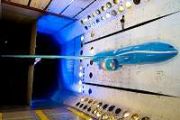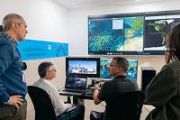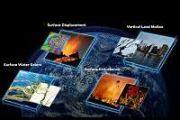
Copernical Team
Three years of Marsquake measurements
 The InSight mission on Mars is running out of power and most of its functions could be shut down in the months to come. Some have already been deactivated. However, the attached seismometer, SEIS, will remain in operation for as long as possible. ETH Professor Domenico Giardini takes stock of three years of marsquake measurements.
NASA's InSight lander successfully touched down on Mars on
The InSight mission on Mars is running out of power and most of its functions could be shut down in the months to come. Some have already been deactivated. However, the attached seismometer, SEIS, will remain in operation for as long as possible. ETH Professor Domenico Giardini takes stock of three years of marsquake measurements.
NASA's InSight lander successfully touched down on Mars on Venus Aerospace unveils mach 9 hypersonic spaceplane Stargazer
 Venus Aerospace, a startup developing hypersonic aircraft, introduced the "Stargazer", the company's first conceptual vehicle design, at the Up.Summit in Bentonville, Arkansas.
The Venus Vehicle Engineering Team has been working on this iteration since the company's founding in 2020. Backed by leading Venture Capitalists and with $1M in government funding, Venus has since raised over $33M
Venus Aerospace, a startup developing hypersonic aircraft, introduced the "Stargazer", the company's first conceptual vehicle design, at the Up.Summit in Bentonville, Arkansas.
The Venus Vehicle Engineering Team has been working on this iteration since the company's founding in 2020. Backed by leading Venture Capitalists and with $1M in government funding, Venus has since raised over $33M The Aonia Terra region of Mars in colour
 Mars, Earth's neighbouring planet, is not particularly known for its colourful appearance. It is usually thought of as an orange-brown expanse, stretching as far as the eye - or at least the cameras on rovers and spacecraft - can see. But there are landscapes that are a veritable kaleidoscope of colour by Martian standards. One such area has been captured in the latest images from DLR's Mars cam
Mars, Earth's neighbouring planet, is not particularly known for its colourful appearance. It is usually thought of as an orange-brown expanse, stretching as far as the eye - or at least the cameras on rovers and spacecraft - can see. But there are landscapes that are a veritable kaleidoscope of colour by Martian standards. One such area has been captured in the latest images from DLR's Mars cam What happened before, during and after solar system formation
 Asteroids and comets represent the material that was left over after the formation of the planets that orbit the Sun. Such bodies would have initially formed in a vast disk of gas and dust (protosolar nebular) around what would eventually become the Sun (protosun) and thus can preserve clues about the processes that operated during this period of the Solar system. The protosolar nebular would ha
Asteroids and comets represent the material that was left over after the formation of the planets that orbit the Sun. Such bodies would have initially formed in a vast disk of gas and dust (protosolar nebular) around what would eventually become the Sun (protosun) and thus can preserve clues about the processes that operated during this period of the Solar system. The protosolar nebular would ha Artemis II engine section moves to final assembly
 On May 24, 2022, the core stage production team moved the Space Launch System (SLS) rocket engine section for Artemis II to the core stage final integration area at NASA's Michoud Assembly Facility in New Orleans.
While there, the engine section team is completing installation of the main propulsion systems, finishing integration of the electrical and avionics systems, and preparing for fu
On May 24, 2022, the core stage production team moved the Space Launch System (SLS) rocket engine section for Artemis II to the core stage final integration area at NASA's Michoud Assembly Facility in New Orleans.
While there, the engine section team is completing installation of the main propulsion systems, finishing integration of the electrical and avionics systems, and preparing for fu Scientists release first analysis of rocks plucked from speeding asteroid
 After a six-year journey, a plucky spacecraft called Hayabusa2 zinged back into Earth's atmosphere in late 2020 and landed deep in the Australian outback. When researchers from the Japanese space agency JAXA opened it, they found its precious payload sealed and intact: a handful of dirt that Hayabusa2 managed to scoop off the surface of a speeding asteroid.
Scientists have now begun to ann
After a six-year journey, a plucky spacecraft called Hayabusa2 zinged back into Earth's atmosphere in late 2020 and landed deep in the Australian outback. When researchers from the Japanese space agency JAXA opened it, they found its precious payload sealed and intact: a handful of dirt that Hayabusa2 managed to scoop off the surface of a speeding asteroid.
Scientists have now begun to ann China releases new geologic map of Moon
 China has released a new geologic map of the Moon on a scale of 1:2,500,000, the first one in the world, according to the Chinese Academy of Sciences (CAS).
Chinese scientists from the Institute of Geochemistry of the CAS and other research institutes and universities have created the map based on data from the country's Chang'e project and other data and research findings from internation
China has released a new geologic map of the Moon on a scale of 1:2,500,000, the first one in the world, according to the Chinese Academy of Sciences (CAS).
Chinese scientists from the Institute of Geochemistry of the CAS and other research institutes and universities have created the map based on data from the country's Chang'e project and other data and research findings from internation Comet chaser mission moves from blueprint to reality
 The Comet Interceptor mission was formally adopted by the European Space Agency (ESA) at a meeting in Madrid today (Wednesday, 8 June 2022), moving from the design phase to implementation, with the next step to select a contractor to build the spacecraft and a robotic probe.
Due for launch in 2029, it will see one main spacecraft and two robotic probes - the other built by the Japanese Spa
The Comet Interceptor mission was formally adopted by the European Space Agency (ESA) at a meeting in Madrid today (Wednesday, 8 June 2022), moving from the design phase to implementation, with the next step to select a contractor to build the spacecraft and a robotic probe.
Due for launch in 2029, it will see one main spacecraft and two robotic probes - the other built by the Japanese Spa How Perseverance averts collisions and zaps
 Perseverance has a number of moving parts, including the robotic arm, drill, mast, instrument covers, high gain antenna, and mobility system. An unintended collision with the rover body or Martian terrain during motion could cause irreparable damage. In addition, the SuperCam instrument shoots the LIBS laser at the surface to create a plasma and perform spectroscopy, and we also want to prevent
Perseverance has a number of moving parts, including the robotic arm, drill, mast, instrument covers, high gain antenna, and mobility system. An unintended collision with the rover body or Martian terrain during motion could cause irreparable damage. In addition, the SuperCam instrument shoots the LIBS laser at the surface to create a plasma and perform spectroscopy, and we also want to prevent Women in space analogues demonstrate more sustainable leadership
 A new study based on Mars Desert Research Station commanders' reports reveals differences in female and male leadership behaviour. Although both genders are task-focused, women tend to be more positive. The genders also differ in their approach toward their team - while men focus on accomplishments, women emphasise mutual support. According to the author of the study, Inga Popovaite, a sociologi
A new study based on Mars Desert Research Station commanders' reports reveals differences in female and male leadership behaviour. Although both genders are task-focused, women tend to be more positive. The genders also differ in their approach toward their team - while men focus on accomplishments, women emphasise mutual support. According to the author of the study, Inga Popovaite, a sociologi 



































